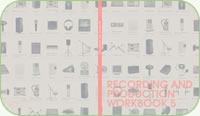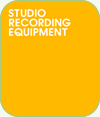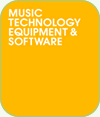 workbook
5
workbook
5 Recording & Production
Workbook 5 contains 5 chapters
Chapter 1: Studio Recording Equipment
Chapter 2: Music Technology Equipment and Software
Chapter 3: Production
Chapter 4: Manufacture
Chapter 5: Live Sound
Chapter
1: Studio Recording Equipment
 This
chapter is about recording studios and recording equipment – the
places and equipment used to capture sound, mix it and turn
it into a CD or other master.
This
chapter is about recording studios and recording equipment – the
places and equipment used to capture sound, mix it and turn
it into a CD or other master.
We will start with an overview of recording studios, such as the types and uses of studios, which will then develop into the different recording formats.
We will look at microphones, mixing desks and other studio equipment, concentrating on how to use them to record different types of instrument and sound sources.
We will finish off by looking at the mix process, including using effects and producing a master.
Go to chapter 1 now
 This
chapter is about recording studios and recording equipment – the
places and equipment used to capture sound, mix it and turn
it into a CD or other master.
This
chapter is about recording studios and recording equipment – the
places and equipment used to capture sound, mix it and turn
it into a CD or other master.We will start with an overview of recording studios, such as the types and uses of studios, which will then develop into the different recording formats.
We will look at microphones, mixing desks and other studio equipment, concentrating on how to use them to record different types of instrument and sound sources.
We will finish off by looking at the mix process, including using effects and producing a master.
Go to chapter 1 now
Chapter
2: Music Technology Equipment & Software
 This
chapter is about music technology equipment and software and
follows on from the recording principles outlined in chapter
one. Music technology generally refers to computers and music.
This
chapter is about music technology equipment and software and
follows on from the recording principles outlined in chapter
one. Music technology generally refers to computers and music.
We will start with an overview of the hardware – different computer platforms, a bit of history of music technology and advice on choosing the right equipment.
We will look at software – from recording software to software synthesizers and samplers to software effects and plug ins.
We will look at technology, in terms of using it to do the job and getting the best out of it.
We will finish off by looking at troubleshooting, giving you some simple advice on problems and solutions.
Go to Chapter 2 now
 This
chapter is about music technology equipment and software and
follows on from the recording principles outlined in chapter
one. Music technology generally refers to computers and music.
This
chapter is about music technology equipment and software and
follows on from the recording principles outlined in chapter
one. Music technology generally refers to computers and music.We will start with an overview of the hardware – different computer platforms, a bit of history of music technology and advice on choosing the right equipment.
We will look at software – from recording software to software synthesizers and samplers to software effects and plug ins.
We will look at technology, in terms of using it to do the job and getting the best out of it.
We will finish off by looking at troubleshooting, giving you some simple advice on problems and solutions.
Go to Chapter 2 now
Chapter
3: Production
 Production
is the process of getting a sound recording made.
This chapter gives you an introduction to production,
including the role of a producer and an insight
into different production styles.
Production
is the process of getting a sound recording made.
This chapter gives you an introduction to production,
including the role of a producer and an insight
into different production styles.
Music production is a critical part of the music industry. Understanding some of the processes by which sound recordings are produced is useful for all musicians and DJs
Go to Chapter 3 now
 Production
is the process of getting a sound recording made.
This chapter gives you an introduction to production,
including the role of a producer and an insight
into different production styles.
Production
is the process of getting a sound recording made.
This chapter gives you an introduction to production,
including the role of a producer and an insight
into different production styles.Music production is a critical part of the music industry. Understanding some of the processes by which sound recordings are produced is useful for all musicians and DJs
Go to Chapter 3 now
Chapter
4: Manufacture
 This
chapter is about what you can do with your recordings
once they are mastered.
This
chapter is about what you can do with your recordings
once they are mastered.
We will start with an overview of the different destinations for recordings, from sending a demo to record companies to selling online.
We will look at packaging of your recordings, and then we will look at CD duplication, from doing it yourself with a computer to getting thousands of copies manufactured.
This will be continued by looking at DVD and surround sound, as these are the audio formats of the future.
The chapter will conclude by looking at MP3 and internet audio.
Go to Chapter4 now
 This
chapter is about what you can do with your recordings
once they are mastered.
This
chapter is about what you can do with your recordings
once they are mastered.We will start with an overview of the different destinations for recordings, from sending a demo to record companies to selling online.
We will look at packaging of your recordings, and then we will look at CD duplication, from doing it yourself with a computer to getting thousands of copies manufactured.
This will be continued by looking at DVD and surround sound, as these are the audio formats of the future.
The chapter will conclude by looking at MP3 and internet audio.
Go to Chapter4 now
Chapter
5: Live Sound
 Live
sound is the term used for ensuring that performers
can be heard when performing in public. This
chapter is about live sound from a musician and
DJ’s point of view, and aims to give an
introduction into the sorts of equipment and
systems available, and how to set it up and get
a good sound.
Live
sound is the term used for ensuring that performers
can be heard when performing in public. This
chapter is about live sound from a musician and
DJ’s point of view, and aims to give an
introduction into the sorts of equipment and
systems available, and how to set it up and get
a good sound.
We will start by looking at Public Address systems (PA’s) and their uses.
We will then look in detail at situations where PAs are used and what you might need, including small (pub) gigs, karaoke and permanently installed PAs.
We will then look at techniques for getting a good sound. It will help if you have read chapter one before reading this section.
We will conclude by looking at Health and Safety, from a setting up and performance point of view.
Go to Chapter5 now
 Live
sound is the term used for ensuring that performers
can be heard when performing in public. This
chapter is about live sound from a musician and
DJ’s point of view, and aims to give an
introduction into the sorts of equipment and
systems available, and how to set it up and get
a good sound.
Live
sound is the term used for ensuring that performers
can be heard when performing in public. This
chapter is about live sound from a musician and
DJ’s point of view, and aims to give an
introduction into the sorts of equipment and
systems available, and how to set it up and get
a good sound.We will start by looking at Public Address systems (PA’s) and their uses.
We will then look in detail at situations where PAs are used and what you might need, including small (pub) gigs, karaoke and permanently installed PAs.
We will then look at techniques for getting a good sound. It will help if you have read chapter one before reading this section.
We will conclude by looking at Health and Safety, from a setting up and performance point of view.
Go to Chapter5 now
Workbook
5 - downloads
| Description | Data size | Download time (estimates) |
| Index of workbook 5 | 164Kb | 56K Modem = 26 sec | Broadband = 3 sec |
| Complete Workbook 5 | 6605kb | 56K Modem = 18 minutes | Broadband = 2 min 20 sec |
All downloads are in Adobe Acrobat PDF format. |
||








